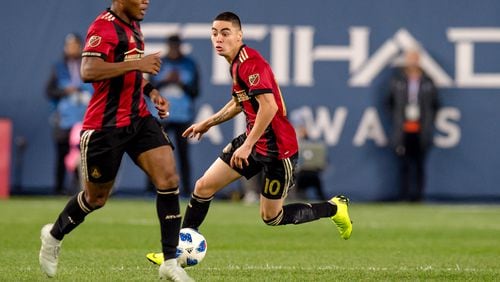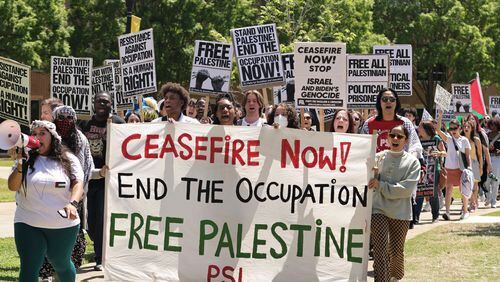One question dominated the queries more than any other in the Atlanta United mailbag: If Miguel Almiron remains with the team, can it still bring on Pity Martinez?
On the surface, it seems like a simple question with a simple answer.
Yes, of course.
What team wouldn’t want to acquire as much talent as it possibly could. That’s the model for most every league around the world.
Plus, Atlanta United owner Arthur Blank and team president Darren Eales have said they don’t need to sell Almiron.
But, as with most things, the answer is very complicated and Paul Tenorio was gracious enough to help me cut through the weeds that is the MLS rulebook.
Short answer: Yes, it is impossible for the team to be able to bring on Pity Martinez to join Almiron, Josef Martinez and Ezequiel Barco.
Long answer: Let’s dive into the math, and hope that I’m right because this is as dense as the statistics class I took while earning an MBA.
For those new to supporting Atlanta United and MLS, there are things that you may not know about the league’s structure and how it impacts the signing of players. It is information that you must have to understand why an Almiron/Pity Martinez/Barco/J. Martinez quartet is impossible.
In MLS, each team is allowed three Designated Players. A DP is a player whose salary cap charge exceeds $1.53 million per year for the 2019 season. Atlanta United’s three DPs are Almiron, Barco and Josef Martinez. Almiron’s guaranteed compensation in 2018 was $2.3 million, Barco’s was $1.43 million and Martinez’s $1.4 million. We should assume those salaries will increase next season. Guaranteed compensation does not include transfer and loan fees, nor projected achievable incentive bonuses (two components which go into a player's budget charge) but it does include base salary, annualized marketing money, agent fees, signing- and other lump sum bonuses.
In MLS, teams can use a financial mechanism known as Allocation Money to buy down a player's salary if it is between $504,000 (maximum budget charge) and $1,504,000 (this season), turning that player from a DP into a regular player for the purpose of staying within the rules. Atlanta United did this with Hector Villalba last season in order to acquire Barco.
To use AM to buy down a salary, a team must first calculate the player’s actual budget charge, which is their annualized salary plus their amortized transfer fee and a few other items. That total will always be more than a player’s guaranteed compensation.
So, turning back to Atlanta United’s three DPs and the use of AM to bring on, in effect, a fourth DP.
Using Almiron as the first example: He can’t be bought down because his guaranteed compensation of $2.3 million exceeds the $1,504,000 ceiling.
Barco’s salary is only $1.4 million, but adding in the average of his transfer fee of reportedly $15 million for however many years of the contract will exceed the ceiling.
Now, let’s look at Josef Martinez. Again, the math doesn’t work within the rules.
His salary in 2018 was $1.4 million. The transfer fee reportedly paid during the 2017 season by Atlanta United to Torino was $5.1 million. The length of the contract isn’t known, other than it’s for multiple years. For the purposes of this exercise, let’s say his contract was for four years. That would bring a cap hit of his $1.4 million salary plus $1.275 million transfer fee, or $2.675 million. He exceeds the ceiling.
So, the only way that the team can add Pity Martinez and keep Almiron is if it were to sell or loan one of its other DPs, Josef Martinez or Barco.
Barco would seem the likeliest candidate. He came in with extremely high expectations as the most expensive transfer in MLS history and by the end of the season was no longer starting. Some of that was a function of manager Gerardo Martino going back to a 3-5-2 formation that put an emphasis on defense, which is something that Barco is working to improve. Some of it was a function of Barco’s lack of punch on offense. An excellent dribbler in tight spaces and passer, he showed a reluctance to shoot and seemed more willing to try to win fouls than to take opponents on one-on-one.
Q: Will Chris Goslin and Lagos Kunga factor into first team at all next year? With the team not exercising options on Oliver Shannon and Andrew Wheeler-Omiunu is it likely they seek to sign them to A2 contracts after waivers draft... or are they cutting ties and moving on?
A: Because neither played for the senior team during the 2018 season, I think it unlikely that Goslin and Kunga, two of the team's five Homegrown Players, will see significant minutes with Atlanta United during 2019. I think they could make a few 18s, but it's more likely they will continue to gain experience with Atlanta United 2 in the USL.
Q: Both interested and confused as to what is happening with the USL and Atlanta United 2. How does AU2 fit into whatever is happening, i.e., are they 1st division, 2nd division etc.. and what other teams are in their level. Thanks.
A: I've asked the club but have yet to receive an answer if ATLUTD2 will stay in USL or drop to USL2.
Q: With Greg Garza gone, does this leave room for George Bello to crack the squad? What’s the plan with his absence?
A: Yes, I think the door is wide open for Bello to build on his one start in 2018.
The issue is it is likely that Bello, 16, will play in two youth World Cups (U-17 and U-20) and next season, so his team with the senior team will be intermittent.
I think he will get a few starts with Jose Hernandez and Chris McCann receiving the rest.
Q: Will the team receive rings?
A: Yes. I'm waiting on details. It appears that it is something the league is in charge of.
About the Author







